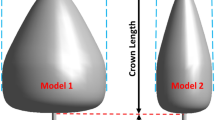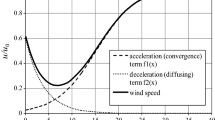Abstract
Large-eddy simulation of atmospheric flow is combined with golf ball trajectory modeling that incorporates local plant canopy information to predict the trajectory of a golf shot at any hole on a golf course in a variety of wind conditions. The model is applied to examine golf shots on hole 12 of the Augusta National Golf Club, which is particularly well known for its wind-induced difficulty. The results indicate that the tree canopies around this hole play a significant role in golf ball trajectories and also induce a strong directional sensitivity on the landing spot of the ball for this hole.










Similar content being viewed by others
References
Woods T One of the hardest par-3s in the world; you don’t know where the wind is coming from. www.Fatpat.Com/Software/Personal/Augusta/Hole12.htm
Nicklaus J Probably one of the most difficult wind-condition par-3s in all of Golf. Not a hard hole without the wind. www.Fatpat.Com/Software/Personal/Augusta/Hole12.htm
No. 12 Golden bell, masters. www.Augusta.Com/Masters/Coursetour/hole12. Accessed 15 Nov 2015
Nicklaus J The first time I played the hole was in 1959. I was with Roger McManus, a Good Amateur. Roger Hit first and flew the green with a 6-iron. I hit a 7-iron and didn’t get halfway across Rae’s Creek that was my introduction to the wind at the 12th. www.Golfdigest.Com/Story/Augusta-12th-Hole-Guy-Yocom
Player G My first experience at Augusta, Ben Hogan and Sam Snead were playing together. Hogan gets up and hits a 7-iron in the back trap. Snead looks in Hogan’s bag and he gets up and hits an 8-iron in the water that was a terrible way for me to have my first look at the 12th. They are two of the greatest strikers of the Golf Ball who ever lived, and you have one in the water and one over the green. I said, ‘man, there must be something to this hole,’ and of course, over the years, you realize it’s true. www.Golfdigest.Com/Story/Augusta-12th-Hole-Guy-Yocom
Yocom G (2012) Swirling down the drain. Last modified february 29, 2012. www.Golfdigest.Com/Story/Augusta-12th-Hole-Guy-Yocom. Accessed 29 Dec 2015
PGA Masters Tournament (2015). www.Pga.Com/Masters/Course/2015//Tour/12. Accessed 05 Oct 2015
Choi J, Jeon W, Choi H (2006) Mechanism of drag reduction by dimples on a sphere. Phys Fluids 18:041702
Beratlis N, Squires K, Balaras E (2012) Numerical investigation of magnus effect on dimpled spheres. J Turbul 13:1–15
Smith C, Beratlis N, Balaras E, Squires K, Tsunoda M (2010) Numerical investigation of the flow over a golf ball in the subcritical and supercritical regimes. Int J Heat Fluid Flow 31:262–273
Aoki K, Muto K, Okanaga H (2010) Aerodynamic characteristics and flow pattern of a golf ball with rotation. Procedia Eng 2:2431–2436
Seo S, Nam C, Han J, Hong C (2013) Drag reduction of a bluff body by Grooves laid out by design of experiment. J Fluids Eng 135:111202
Daemi N, Henning S, Gibert J, Yuya P, Ahmadi G (2016) On generalized rolling of golf balls considering an offset center of mass and rolling resistance: a study of putting. Sports Eng 19:35–46
Balzerson D, Banerjee J, McPhee J (2016) A three-dimensional forward dynamic model of the golf swing optimized for ball carry distance. Sports Eng 19:237–250
Bearman P, Harvey J (1976) Golf ball aerodynamics. Aeronaut Q 27:112–122
Mehta RD (1985) Aerodynamics of sports balls. Annu Rev Fluid Mech 17:151–189
Dormand JR, Prince PJ (1980) A family of embedded Runge-Kutta formulae. J Comput Appl Math 6:19–26
Trackman average tour stats, last modified June 6, 2014, Accessed October 7 2015. https://Blog.Trackmangolf.Com/Trackman-Average-Tour-Stats
PALM—a parallelized large-eddy simulation model for atmospheric and oceanic flows. https://palm.muk.uni-hannover.de/trac
Wicker LJ, Skamarock WC (2002) Time-splitting methods for elastic models using forward time schemes. Mon Weather Rev 130:2088–2097
Williamson J (1980) Low-storage runge-kutta schemes. J Comput Phys 35:48–56
Deardorff JW (1980) Stratocumulus-capped mixed layers derived from a three-dimensional model. Bound-Layer Meteorol 18:495–527
Maronga B, Gryschka M, Heinze R, Hoffmann F, Kanani-Sühring F, Keck M, Ketelsen K, Letzel MO, Sühring M, Raasch S (2015) The parallelized large-eddy simulation model (PALM) version 4.0 for atmospheric and oceanic flows: model formulation, recent developments, and future perspectives. Geosci Model Dev Discuss 8:1539–1637
Dupont S, Brunet Y (2008) Impact of forest edge shape on tree stability: a large-eddy simulation study. Forestry 81:299–315
Markkanen T, Rannik Ü, Marcolla B, Cescatti A, Vesala T (2003) Footprints and fetches for fluxes over forest canopies with varying structure and density. Bound-Layer Meteorol 106:437–459
Asner GP, Scurlock JM, Hicke JA (2003) Global synthesis of leaf area index observations: implications for ecological and remote sensing studies. Global Ecol Biogeogr 12:191–205
Cassiani M, Katul G, Albertson J (2008) The effects of canopy leaf area index on airflow across forest edges: large-eddy simulation and analytical results. Bound-Layer Meteorol 126:433–460
Hinze JO (1975) Turbulence, 2nd edn. McGraw-Hill, New York
Pope SB (2000) Turbulent flows. Cambridge University Press, Cambrigde
Hutchins N, Marusic I (2007) Large-scale influences in near-wall turbulence. Philos Trans A 365:647–664
Kanda M, Moriwaki R, Kasamatsu F (2004) Large-eddy simulation of turbulent organized structures within and above explicitly resolved cube arrays. Bound-Layer Meteorol 112:343–368
Perret L, Savory E (2013) Large-scale structures over a single street canyon immersed in an urban-type boundary layer. Bound-Layer Meteorol 148:111–131
Inagaki A, Castillo MCL, Yamashita Y, Kanda M, Takimoto H (2012) Large-eddy simulation of coherent flow structures within a cubical canopy. Bound-Layer Meteorol 142:207–222
Cheng H, Castro IP (2002) Near wall flow over urban-like roughness. Bound-Layer Meteorol 104:229–259
Davidson P (2015) Turbulence: an introduction for scientists and engineers. Oxford University Press, Oxford
Author information
Authors and Affiliations
Corresponding author
Rights and permissions
About this article
Cite this article
Yaghoobian, N., Mittal, R. A computational approach for predicting plant canopy induced wind effects on the trajectory of golf shots. Sports Eng 21, 1–10 (2018). https://doi.org/10.1007/s12283-017-0239-9
Published:
Issue Date:
DOI: https://doi.org/10.1007/s12283-017-0239-9




